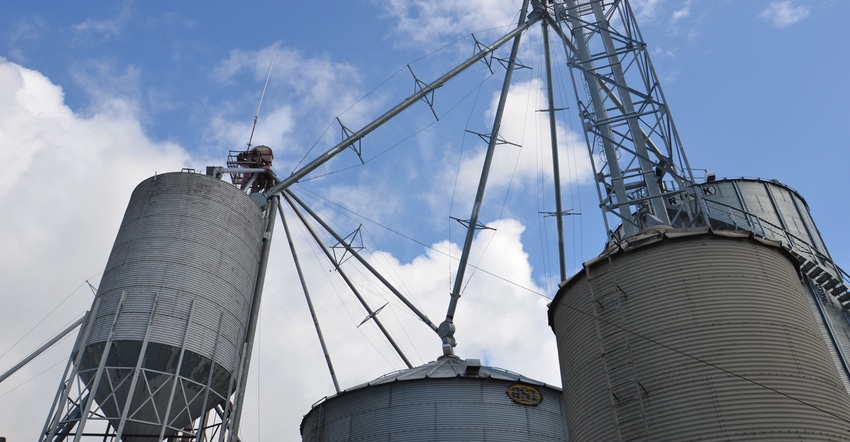
Gary Woodruff has provided tips for grain storage in several Indiana Prairie Farmer articles over the past few months. He is district manager for GSI in Indiana and Kentucky.Recently, a farmer asked a specific question about grain storage.
Gary Holt, Oneida, Ill., has used spider-style grain spreaders in the past. His concern is maintaining proper airflow in the bin, and he wonders if dropping grain in without a spreader and then pulling cores would work. Here is Holt’s question:
Dear Mr. Woodruff,
When not using a grain spreader, fines are supposed to remain in the center of the bin. Is it possible, when not using a grain spreader, most of the fines are drawn by pulling a few cores, resulting in the rest of the bin being relatively fine-free, allowing freer airflow through the deeper grain depths near the wall? We use spider-style grain spreaders, which tend to move fines further out from the center but not as far as the bin wall. I’d guess the outer 10% to 15% of the bin is fine-free. Spiders were put in when we were doing more in-bin cooling, discharging from the dryer at up to 105 degrees F.
We’ve dropped that back to 90 to 95 degrees. I’m not sure we could successfully cool grain dropping it into the center of the bin at 90 to 95 degrees. We have a 42-foot-diameter bin with 27-foot wall height with 15-horsepower centrifugal fan and a 48-foot-diameter bin with 24-foot wall height with 20-horsepower centrifugal fan. Both bins have full perforated floors. Grain spreaders require daily adjustments. From a time and grain management standpoint, would we be better off adding cooling capacity to the dryer and dropping close to ambient outside air temp grain directly into the middle of the bin and then pulling cores?
Specialist responds
Here is Woodruff’s answer:
“In general, a drying and cooling dryer putting grain into a bin within 20 degrees F of ambient temperature do pretty well, either with a good spreader or without any spreader while using repetitive coring.
“There are a couple practices that need to be followed for best results. First, as soon as possible — within a couple weeks at most — pull the center of the bin down below where the grain is on the sidewalls to promote air movement in the center. Some people may level this off even more, but getting it to this point helps a great deal.
“Second, if the bin is tall — say, 30-foot eaves or taller — multiple coring becomes the best tool to minimize blocked airflow or plugged unloading equipment. Elevators have done this regularly for many years, and with the average farmer utilizing as big or bigger bins than the elevators 40 years ago, this practice will work well on today’s farm.
“It’s simple but does take a plan and follow-through. Drop the grain directly into the bin without a spreader.
“While filling the bin, at every 8 to 10 feet of depth, pull a 9-foot- to 10-foot-diameter cone out of the peak, and either market that grain as it accumulates, or move it to another smaller bin that will be marketed first. This removes a significant percentage of fines which will otherwise stay in the middle. It greatly improves airflow through the middle of the bin.
“You still need to pull the bin down below the sidewall depth to get the best results.
“Multiple coring doesn’t work well with an all-heat dryer. It changes the movement of air in different parts of the bin, and with up to 140-degree grain, the grain pile needs to be cooled quickly and evenly and not left to sit. This makes using multiple coring for both cool and hot corn in the same bin difficult.
“So, yes, if you can increase the cooling capacity of your dryer, bringing the grain down closer to ambient temperature, you can use multiple coring successfully with less management and risk. Since about 1998, GSI/Zimmerman tower dryers have utilized vacuum cooling, and today use heat recovery at the bottom of the drying chamber to dry less expensively than all-heat dryers. GSI stack dryers have heat recoveries available that also bring them to equal efficiency to an all-heat dryer.
“Anytime you dry and put out cool grain, there has to be a significant amount of heat recovery in the dryer, or drying costs will be higher than with an all-heat dryer. All-heat dryers have been popular due to their relative good efficiency and lower cost. But you must stick with properly equipped bins with proper venting and fan-delivered air without too much temperature rise across the fan at 50,000 bushels in size or smaller to cool the grain without problems.
“Quite a few bins, both for cool and hot grain, wind up with too little square feet of vent opening. One quick test is when the bin is three-quarters to full or more, run the fans and unlatch the manhole opening. It should not blow open, as that indicates a very high pressure in the head space of the bin.
“The door should remain closed or lift a little and hover, which indicates there is adequate venting. Inadequate venting causes the fan to run at too high a static pressure, reducing airflow, increasing the temperature rise of the air and consuming a great deal more electricity than necessary.”
About the Author(s)
You May Also Like




